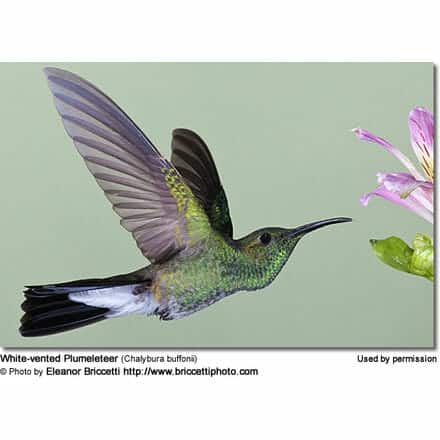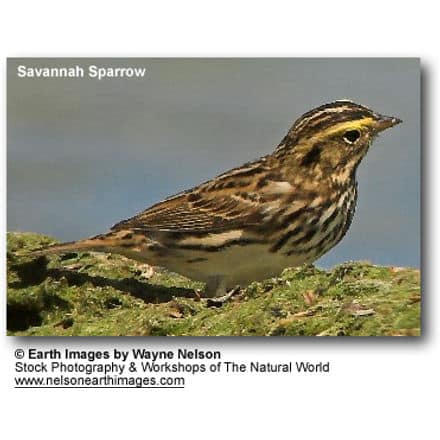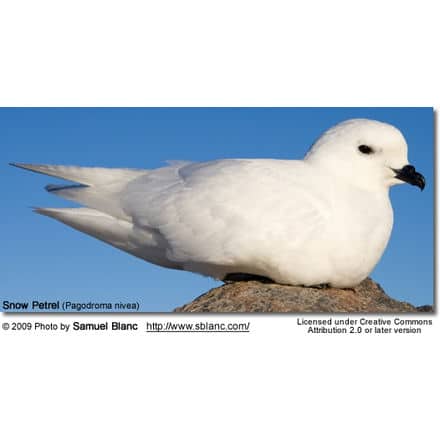White-vented Plumeleteers – Hummingbirds
The White-vented Plumeleteers (Chalybura buffonii) are fairly common South American hummingbirds that occur naturally in Colombia, Ecuador, Panama, Peru, and Venezuela.
They inhabit humid woodland, secondary growth, and open forest borders (usually not inside dense forests) of lowlands and lower highlands. They are usually seen singly or in pairs in the lower story of woodland or along shady borders.
Subspecies and Distribution
- Chalybura buffonii buffonii (Lesson, 1832) – Nominate Race
- Found in central Colombia (upper and middle Magdalena Valley) to the south and western regions of the lower Maracaibo basin and adjacent slopes in extreme northeastern Colombia and northwestern Venezuela
- Chalybura buffonii micans (Bangs and Barbour, 1922)
- Found in central and eastern Panama and western Colombia (along the Pacific slope, Cauca Valley, and head of Magdalena Valley)
- Chalybura buffonii aeneicauda (Lawrence, 1865)
- Found in northern Colombia (lower Magdalena Valley and Santa Marta region) to western and north-central Venezuela (along the southern slope of Andes and on the coastal slope)
- Chalybura buffonii caeruleogaster (Gould, 1847)
- Found in northern and central Colombia (the eastern slope of east Andes)
Hummingbird Resources
- Hummingbird Information
- Hummingbird Amazing Facts
- Attracting Hummingbirds to Your Garden
- Hummingbird Species
- Feeding Hummingbirds
Description
The male White-vented Plumeleteers average 4.5” (11.4 cm) in length. The female is slightly smaller, averaging 4.2” (10.7 cm) in length. The moderately long, slightly curved beak is about 1” or 25mm long.
The male’s upper plumage is glossy green. The underplumage is also mostly green except the subspecies Chalybura buffonii caeruleogaster’s chest and the center of its abdomen is glossy blue. The long puffy under-tail feathers are silky blue. The upper side of the tail is blue-black. The tail is slightly forked.
The female is green above and greyish on the underside. Her tail looks like the male’s, except the outer tail feathers are tipped in white, with a dusky band across the tail.
Similar species: Female woodnymphs can easily be confused with female White-vented plumeteers, but they are smaller and have shorter tails.
White-vented Plumeleteers are also often confused with the Scaly-breasted Hummingbirds; female White-necked Jacobins; and Crowned / Mexican Woodnymph
Nesting / Breeding
The breeding season usually starts in March and continues until October.
Hummingbirds are solitary in all aspects of life other than breeding, and the male’s only involvement in the reproductive process is the actual mating with the female. They neither live nor migrate in flocks, and there is no pair bond for this species. Males court females by flying in a U-shaped pattern in front of them. He will separate from the female immediately after copulation. One male may mate with several females. In all likelihood, the female will also mate with several males. The males do not participate in choosing the nest location, building the nest, or raising the chicks.
The female White-vented Plumeleteer is responsible for building the cup-shaped nest out of plant fibers woven together and green moss on the outside for camouflage in a protected location in a shrub, bush, or tree.
She lines the nest with soft plant fibers, animal hair, and feathers down, and strengthens the structure with spider webbing and other sticky material, giving it an elastic quality to allow it to stretch to double its size as the chicks grow and need more room. The nest is typically found on a low, skinny horizontal branch.
The average clutch consists of two white eggs, which she incubates alone, while the male defends his territory and the flowers he feeds on. The young are born blind, immobile, and without any down.
The female alone protects and feeds the chicks with regurgitated food (mostly partially digested insects since nectar is an insufficient source of protein for the growing chicks). The female pushes the food down the chicks’ throats with her long bill directly into their stomachs.
As is the case with other hummingbird species, the chicks are brooded only the first week or two and are left alone even on cooler nights after about 12 days – probably due to the small nest size. The chicks leave the nest when they are about 20 days old.

Diet / Feeding
The White-vented Plumeleteers primarily feed on nectar taken from a variety of brightly colored, scented small flowers of trees, herbs, shrubs, and epiphytes. They favor flowers with the highest sugar content (often red-colored and tubular-shaped) and seek out, and aggressively protect, those areas containing flowers with high-energy nectar.
They use their long, extendible, straw-like tongues to retrieve the nectar while hovering with their tails cocked upward as they are licking at the nectar up to 13 times per second. Sometimes they may be seen hanging on the flower while feeding.



